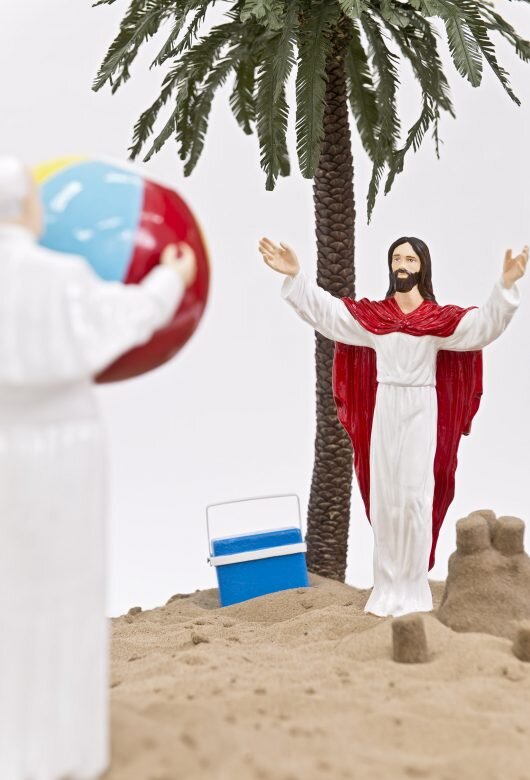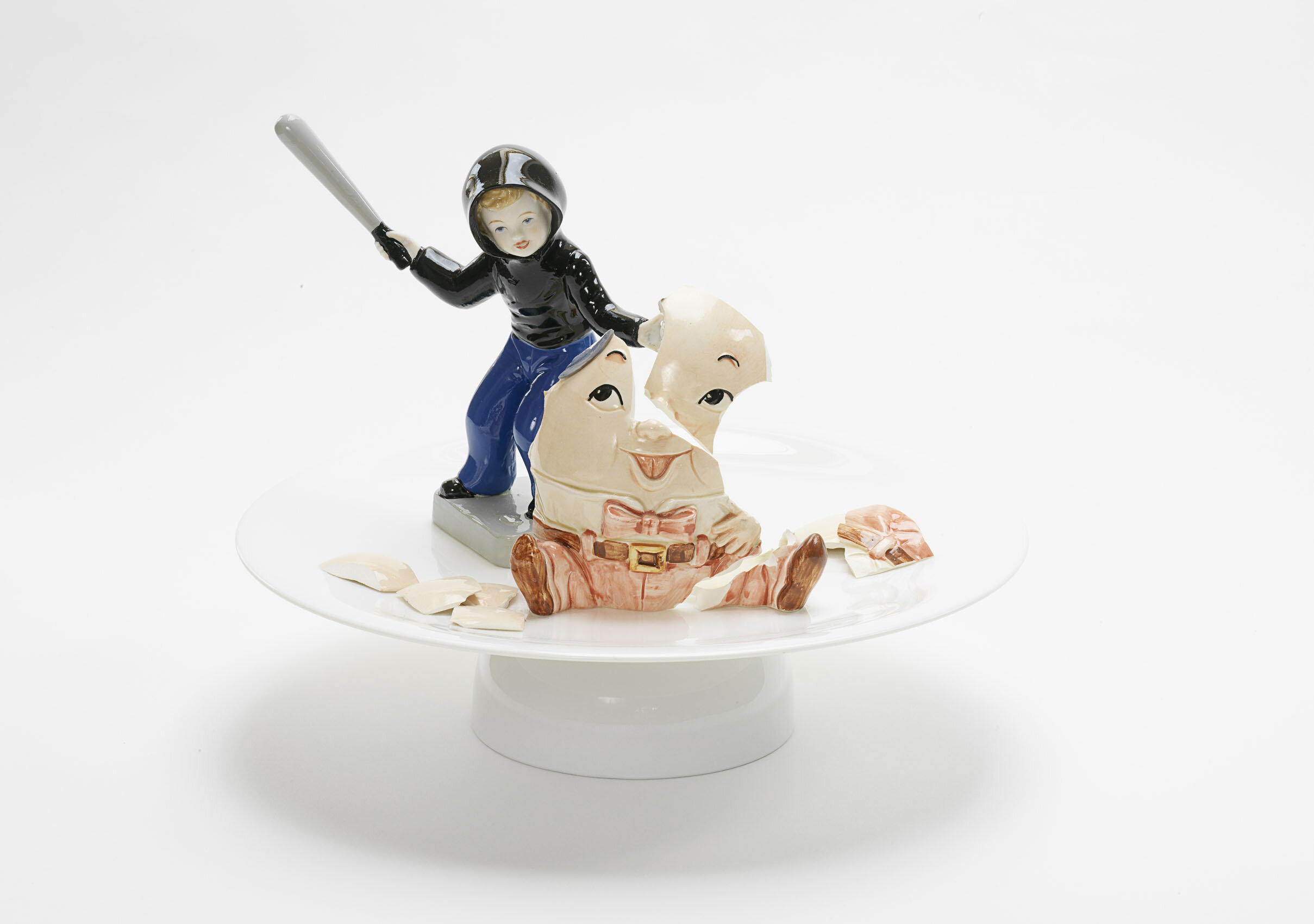Barnaby Barford: subverting the image
Seemingly homely objects and politics have a long tradition as bedfellows. From the glassware of the Jacobean rebellion (which was easily destroyed if you were interrupted mid-toast) to the quilt making of Pinochet-era Chile, craft can be an ‘ideal vehicle for conveying potentially unsettling messages’ through code or subversion.1 The combination of universal familiarity with day-to-day ceramic objects and the safety of decorative art leaves viewers exposed to being blind-sided by contemporary political connotations when used as a medium for contemporary art. Luckily, Barnaby Barford lives in an age and country where there is freedom to make art that challenges politics, governments, societies and ideologies, but that is still not a given set of freedoms around the world: until recently art was subject to review by morality agencies in Saudi Arabia and many artists were involved in the dissemination of anti-government information during the Sudan Revolution that could easily have led to their incarceration or worse.
“… porcelain figurines continue to be considered the epitome of bourgeois respectability: elegant ladies made by Meissan, Wedgwood or Royal Doulton, or cheap cherubic youths that might adorn a mantelpiece or a sideboard in a suburban living room. Barford’s work derives much of its power from subverting the image and social expectation of such pieces.”2
“We are all comfortable with it: we eat off it, drink out of it, but it’s not a material we expect to find challenging… I really like playing with those preconceptions – it’s just clay, after all.”3
For Barford, the nature and history of ceramics allow multiple layers of meaning, in that his distorted found objects have a visual impact through the juxtaposition of their banal expressions and the humour of his interventions and remodelling. Their titles often add a further layer of depravity, longing, humour or vanity to these snapshot ceramics by contextualising the frozen figurines and completing the stories, making the audiences reflect on the issues Barford presents and their own reactions to them.
“Pieces of Meissan or Lladrò were (and are) designed for the telling of stories… Barford’s figurines, too, tell stories, although their narrative is self-contained.”4
Barford’s early work is possibly the most playful and of the moment of the political pieces made by the artists that I have looked at for this exhibition, with Stick That on YouTube! sharing more in common with Banksy’s Rage, Flower Thrower than Picasso’s Guernica in the history of political artworks. I don’t think it’s unrelated that Barford graduated in 2002, Flickr was launched in 2004, YouTube launched in 2006 and Barford’s Private Lives exhibition was in 2007: this was the dawning of instantaneous sharing, smart phones and social media. Looking back at Barford’s work from the vantage point of 2021, some of it even looks like a precursor to memes.
My first in-person encounter with Barford’s work was his exhibition which toured from the Virginia Museum of Contemporary Art to Dovecot in Edinburgh in 2013. In fact, it perfectly encapsulates what my exhibition this summer wants to portray: this was the artist’s world stylistically, but also everyone’s world in subject, distilled into an exhibition space. It featured his excellent stop-frame animation film Damaged Goods, which further underscored the idea that the sculptures were just freeze-frames in a bigger narrative alluded to by their titles. But the thing that really struck me, as an arts professional and former art student with a burgeoning interest in ceramics, was the fact that Barford was represented by a serious contemporary art dealer based in London. It shouldn’t have come as such a shock, but a gallery in the heart of the British art world presenting playful ceramic sculptures seemed alien to me at the time.
“When you bring humour into play, you disarm people. Suddenly they are laughing, then they think, ‘Actually, I shouldn’t really be laughing,’ and that [humour] exposes a basic human instinct.”5
In the intervening years Barford’s work has changed dramatically in scale: The Tower of Babel at the V&A in 2015 was an incredible 6m tower of porcelain shop frontages, The Tottenham and Croydon Foxes from 2014 were made of ceramic tiles covered in images of the fires and aftermath of the 2011 London riots and More, More, More from 2019 was the culmination of Barford’s work looking at the apple used to tempt Eve and Adam in the Garden of Eden. At heart, though, they are still artworks that dig into the audiences’ relationship with current news and politics using ceramics as their primary medium just as his early figurines did.
“This cast of characters may pose in period attire, but their circumstances, actions, accessories and symbols all signal the twenty-first century. To varying degrees, the protagonists engage in power struggles, gender conflicts, violence and outright naughtiness.”6
These blog posts are published monthly, but if you want to access more exclusive content and to help my research, please consider supporting me on Patreon.
I also post photos daily to my Instagram profile.
Edited by Sarah McGill
1 – Matt Smith; Queering The Museum; 2011; Birmingham Museum & Art Gallery
2 – Simon Martin; Barnaby Barford: Love Is…; 2011; David Gill Galleries
3 – Barnaby Barford; Porcelain Provocateur; 2013; The Sunday Times
4 – Charles Darwent; Barnaby Barford: Private Lives; 2008; David Gill Galleries
5 – Barnaby Barford; Barnaby Barford; 2013; Virginia Museum of Contemporary Art
6 – Alison Byrne; Barnaby Barford; 2013; Virginia Museum of Contemporary Art
Barnaby Barford; Happy Meal; 2013
Barnaby Barford; Fight! Fight! Fight!; 2008
Barnaby Barford; Paradiso; 2013
Barnaby Barford; Stick That On YouTube!; 2008
Barnaby Barford; Fox; 2014
Barnaby Barford; Likes; 2019





